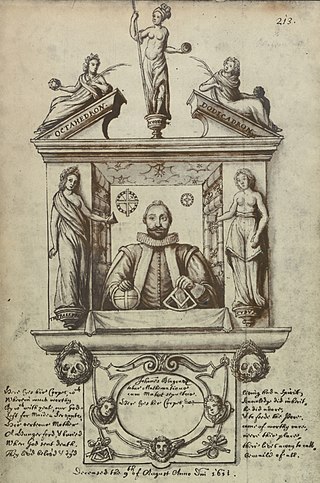Related Research Articles

Giordano Bruno was an Italian philosopher, poet, cosmological theorist and esotericist. He is known for his cosmological theories, which conceptually extended to include the then-novel Copernican model. He proposed that the stars were distant suns surrounded by their own planets (exoplanets), and he raised the possibility that these planets might foster life of their own, a cosmological position known as cosmic pluralism. He also insisted that the universe is infinite and could have no center.

Pope Clement VIII, born Ippolito Aldobrandini, was head of the Catholic Church and ruler of the Papal States from 2 February 1592 to his death, in March 1605.

Sir Francis Walsingham was principal secretary to Queen Elizabeth I of England from 20 December 1573 until his death and is popularly remembered as her "spymaster".

Hermes Trismegistus is a legendary Hellenistic period figure that originated as a syncretic combination of the Greek god Hermes and the Egyptian god Thoth. He is the purported author of the Hermetica, a widely diverse series of ancient and medieval pseudepigraphica that lay the basis of various philosophical systems known as Hermeticism.
This article contains information about the literary events and publications of 1629.
This article contains information about the literary events and publications of 1585.
This article contains information about the literary events and publications of 1584.
The year 1600 CE in science and technology included some significant events.

Giovanni Florio (1552–1625), known as John Florio, was an English linguist, poet, writer, translator, lexicographer, and royal language tutor at the Court of James I. He is recognised as the most important Renaissance humanist in England. Florio contributed 1,149 words to the English language, placing third after Chaucer and Shakespeare, in the linguistic analysis conducted by Stanford professor John Willinsky.
Thomas Digges was an English mathematician and astronomer. He was the first to expound the Copernican system in English but discarded the notion of a fixed shell of immoveable stars to postulate infinitely many stars at varying distances. He was also first to postulate the "dark night sky paradox".

Dame Frances Amelia Yates was an English historian of the Renaissance, who wrote books on the history of esotericism.

John Blagrave of Reading was an English Tudor mathematician, astronomer and designer of astronomical and mathematical instruments. His astrolabe designs, which he described in his writings, were advanced for Britain. He devoted himself to mathematical study and was called, by Anthony à Wood, "the flower of mathematicians of his age"
John Charlewood was an English printer.

Michel de Castelnau, Sieur de la Mauvissière was a French soldier and diplomat, ambassador to Queen Elizabeth. He wrote a memoir covering the period between 1559 and 1570.

Renaissance magic was a resurgence in Hermeticism and Neo-Platonic varieties of the magical arts which arose along with Renaissance humanism in the 15th and 16th centuries CE. During the Renaissance period, magic and occult practices underwent significant changes that reflected shifts in cultural, intellectual, and religious perspectives. C. S. Lewis, in his work on English literature, highlighted the transformation in how magic was perceived and portrayed. In medieval stories, magic had a fantastical and fairy-like quality, while in the Renaissance, it became more complex and tied to the idea of hidden knowledge that could be explored through books and rituals. This change is evident in the works of authors like Spenser, Marlowe, Chapman, and Shakespeare, who treated magic as a serious and potentially dangerous pursuit.
Gerhard Streminger is an Austrian Philosopher and author, born in Graz in 1952. From 1970, he studied philosophy and mathematics in Graz, Goettingen, Edinburgh with G.E.Davie and Oxford with J. L. Mackie. He gained his PhD in 1978 at the University of Graz, where he held posts from 1975 until 1997. In 1981 he was Visiting Professor at the University of Minnesota, Minneapolis. Streminger was appointed Assistant Professor at the University of Graz in 1988 and received the title of University Professor in 1995.
Nuccio Ordine was an Italian literary critic who was professor of Italian literature at the University of Calabria. He was one of the world's top experts on the Renaissance and the philosopher Giordano Bruno.

Nola is a town and a municipality in the Metropolitan City of Naples, Campania, southern Italy. It lies on the plain between Mount Vesuvius and the Apennines. It is traditionally credited as the diocese that introduced bells to Christian worship.
Sylvanus Scory was an English courtier and politician, known as a soldier, covert agent, and dissolute wit.
Fabrizio Mordente was an Italian mathematician. He is best known for his invention of the "proportional eight-pointed compass" which has two arms with cursors that allow the solution of problems in measuring the circumference, area and angles of a circle. In 1567 he published a single sheet treatise in Venice showing illustrations of his device.
References
- ↑ Ford, David Nash (2001). "John Blagrave (c. 1561–1611)". Royal Berkshire History. Retrieved 2011-02-27.
- ↑ Bruno, Giordano (1585), Figuratio Aristotelici Physici auditus
- ↑ "Die Universität im Porträt". University of Graz.